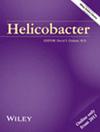HIF-1α-Induced GPR171 Expression Mediates CCL2 Secretion by Mast Cells to Promote Gastric Inflammation During Helicobacter pylori Infection
Abstract
Background
Helicobacter pylori (H. pylori) infection is one of the most important risk factors for chronic gastritis, gastric ulcers, and gastric cancer. Mast cells act as a crucial regulator in bacterial infection. The mechanisms underlying mast cell activation and their role in H. pylori infection remain poorly understood.
Materials and Methods
In gastric mucosal tissue, the number of mast cells, G-protein-coupled receptor 171 (GPR171) and CCL2 expression were detected by immunohistochemistry (IHC) or immunofluorescence between H. pylori-negative and H. pylori-positive patients. Mast cells were co-cultured with H. pylori, and transcriptome sequencing, RT-qPCR, and Western blotting (WB) were performed to identify receptors involved in mast cell activation. WB, chromatin immunoprecipitation (ChIP), and dual-luciferase reporter assays were conducted to investigate the molecular mechanism by which HIF-1α regulates GPR171 expression. Lentiviral knockdown, ELISA, WB, and IHC were used to evaluate the role of GPR171 during H. pylori infection. An in vivo mouse model of H. pylori infection was employed to assess the effects of GPR171 blockade on CCL2 expression and gastric mucosal inflammation.
Results
In the study, we found that mast cell numbers were greatly increased and correlated with the severity of inflammation in H. pylori-infected patients. We found a new receptor, GPR171, was upregulated and involved in mast cell activation upon H. pylori infection. Furthermore, H. pylori infection induced the expression of GPR171 by promoting the activation of hypoxia-inducible factor 1 alpha (HIF-1α), which directly bound to hypoxia response elements in the GPR171 promoter and regulated its transcriptional activity. Blockade or loss of GPR171 in mast cells partially inhibited CCL2 secretion via the ERK1/2 signaling pathway. In the human gastric mucosa, CCL2 derived from mast cells was associated with gastric inflammation during H. pylori infection. In vivo murine studies indicated that H. pylori infection significantly upregulated CCL2 expression, while GPR171 inhibition partially reduced CCL2 levels and alleviated gastric mucosal inflammation.
Conclusions
We provide a novel mechanism that H. pylori activates mast cells to promote gastric inflammation.


 求助内容:
求助内容: 应助结果提醒方式:
应助结果提醒方式:


